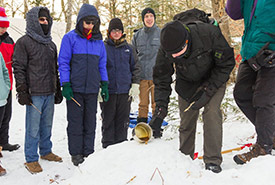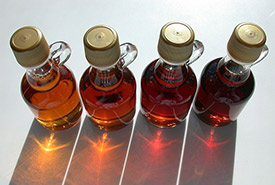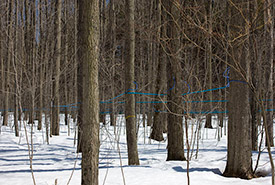Heard it from a Scout: How climate change affects maple syrup production

Scouts pouring hot maple syrup on snow to make maple taffy (Photo by Andrea Burbidge Photography)
Climate change is one of the great challenges of this century. From major natural disasters to large-scale shifts in weather, it's easy to forget about the other ways that climate change is affecting our world. One is on our breakfast table.
Maple syrup is an iconic ingredient in Canadian cuisine and, like all things born in the north, the production of maple syrup feels the effects of climate change. Maple syrup is used in everything from bacon to lattes, with Canada producing 71 per cent of the world’s supply, according to statistics from Agriculture and Agri-Food Canada. To understand the impact of climate change on the industry, it is important to understand the process of producing maple syrup.

Different grades of maple syrup (Photo by Dvortygirl, CC BY-SA 3.0)
It all starts with the trees. The healthier the tree is, the more concentrated the sugar in the sap will be, and the better it will refine into syrup. Sugar is an integral nutrient for sugar maples, as it contributes to wood production, bud growth and also protects the tree from insects, disease and drought. However, summers with intense heat, paired with warmer autumns and springs, disrupt the sugar-making process.
Rising temperatures due to climate change impact tree health by decreasing the rate of photosynthesis, which affects the tree’s ability to produce sugars. With less sugar content in its sap, a tree has less protection from natural elements, and will also produce lower-quality syrup. Additionally, the snow that trees rely on to protect their roots in winter is decreasing. These changes have all contributed to decreased sugar content in the sap by 40 per cent. But that’s just the tip of the proverbial melting iceberg for maple syrup.
Next in the production process is tapping maple trees for sap. In late winter, temperatures drop below freezing at night and rise above freezing during the day. This fluctuation causes pressure that prompts the sap to flow throughout the tree. The period in late winter when these conditions are present is occurring at an earlier time of year, having already risen up to 10 days sooner over the past several decades, which is shortening the tapping season over time. This is a big challenge for maple syrup producers because the shorter the season, the less syrup that producers can get out of their sugar bush.
Climate change is also believed to be causing the sugar maples' range to gradually shift north. As the maple syrup production region shifts north, the United States will feel the impact initially, but Canada’s southern maple producers will also be affected as the sugar maple’s optimal growing areas migrate north in search of ideal temperatures.

Sugar maple sap lines (Photo by Michel Rathwell, Sand Road Maple Sugar Farm Sap Lines)
Another symptom of climate change is weather that interferes with maple tapping, like ice storms and spring-like weather in January. Earning a profit in the maple business is even harder to achieve when these storms result in tree damage, and when heavy branches break and fall onto sap lines — exposed tubing that connects taps from various trees and collects sap. These Mother Nature curve balls are essentially big make-work-projects for the producers.
In the past few decades, producers have already seen a shorter tapping season, shifting tapping regions, reduced sap flow and less sugar in the sap. These consequences of climate change are putting pressure on maple producers. With it being such a staple of Canadian culture, it’s odd to think of a post-maple syrup era — a potential global consequence of climate change.
Luckily, these changes will happen over a long period of time, with the impact being felt little by little, giving researchers time to explore solutions. We can all do our part too by being conscious of our own impact on climate change and by making small changes in our actions.
"Heard it from a Scout" is written by members of Scouts Canada’s Youth Spokesperson program. This post was authored by Jason Gingrich.

